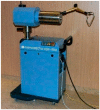Is There Still a Place for Brachytherapy in the Modern Treatment of Early-Stage Oral Cancer?
- PMID: 35008386
- PMCID: PMC8750481
- DOI: 10.3390/cancers14010222
Is There Still a Place for Brachytherapy in the Modern Treatment of Early-Stage Oral Cancer?
Abstract
Brachytherapy (BT) involves the direct application of radioactive sources to the tumour. This technique is characterised by a steep dose gradient, the delivery of high-dose radiation to the target volume centre, and the sparing of surrounding healthy tissues. Low-dose-rate (LDR) BT and manual afterloading played an important role in the treatment of early-stage oral cancer, with treatment outcomes that were comparable to surgery. Interest in BT as a primary treatment for oral cancer has declined in recent years due to the emergence of better surgical techniques, the switch from LDR BT to high-dose-rate (HDR) BT (which has a higher risk of complications), and to advances in external beam radiotherapy (EBRT). At present, the main indications for BT are in the postoperative setting due to the superior dose conformity and better quality of life offered by BT versus EBRT. Postoperative BT can be administered as monotherapy in early-stage (T1N0) cancers and in combination with elective neck dissection or EBRT to treat larger or deeper tumours. BT yields excellent results for lip carcinoma in older patients and in tumours with unfavourable localisations. BT is an effective salvage therapy for local recurrences in previously-irradiated areas. Despite its many advantages, brachytherapy is a complex treatment requiring meticulous technique and close cooperation between the radiation oncologist, physicist, and surgeon.
Keywords: brachytherapy; oral cancer; radiotherapy.
Conflict of interest statement
The authors declare no conflict of interest.
Figures
References
-
- Gatta G., Capocaccia R., Botta L., Mallone S., De Angelis R., Ardanaz E., Comber H., Dimitrova N., Leinonen M.K., Siesling S., et al. Burden and centralised treatment in Europe of rare tumours: Results of RARECAREnet-a population-based study. Lancet Oncol. 2017;18:1022–1039. doi: 10.1016/S1470-2045(17)30445-X. - DOI - PubMed
-
- Machiels J.P., René Leemans C., Golusinski W., Grau C., Licitra L., Gregoire V. Squamous cell carcinoma of the oral cavity, larynx, oropharynx and hypopharynx: EHNS-ESMO-ESTRO Clinical Practice Guidelines for diagnosis, treatment and follow-up. Ann. Oncol. 2020;31:1462–1475. doi: 10.1016/j.annonc.2020.07.011. - DOI - PubMed
Publication types
Grants and funding
LinkOut - more resources
Full Text Sources





